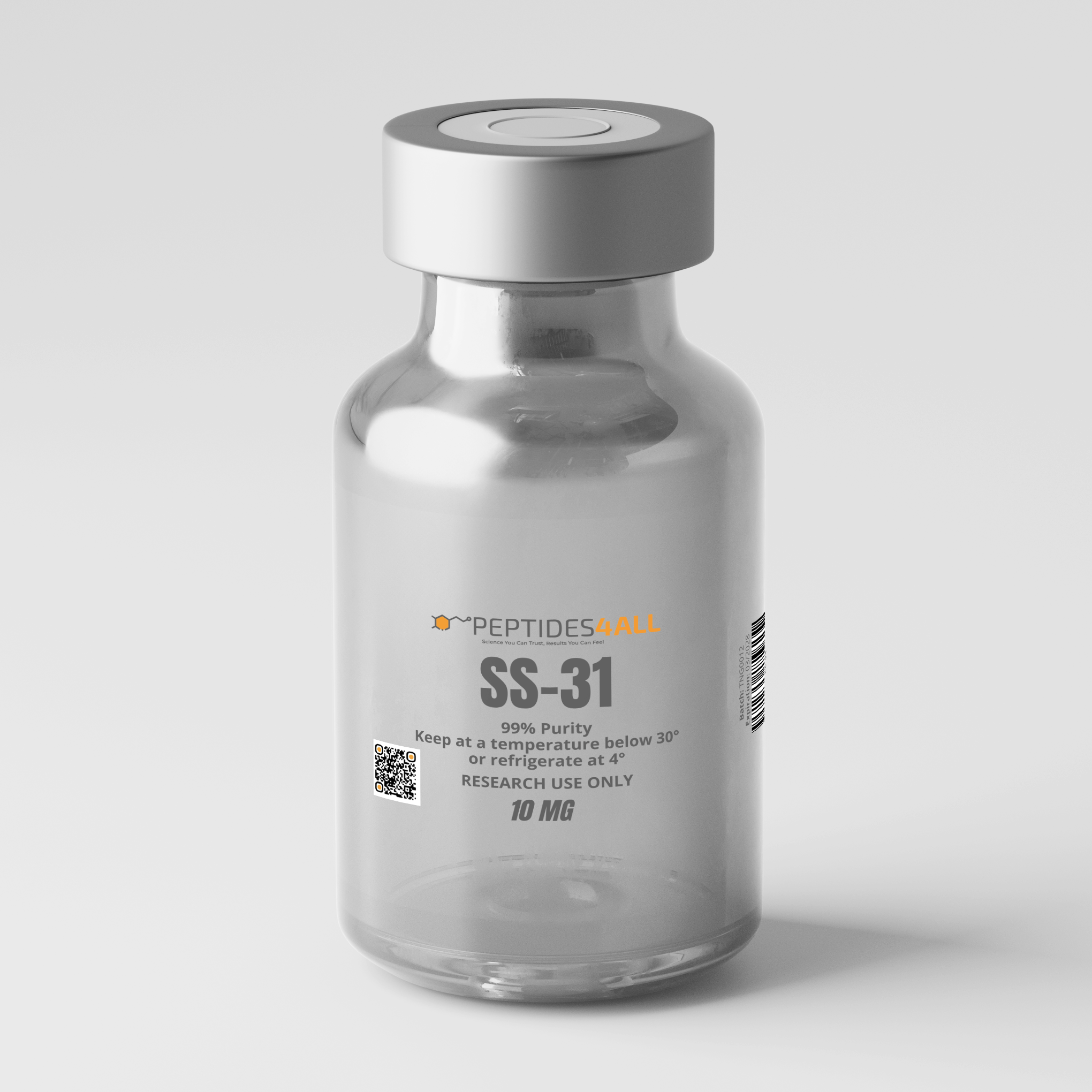PEPTIDES4ALL SS-31 (Elamipretide / Bendavia) – Mitochondria-Targeted Peptide for Cellular Protection & Bioenergetics Research
PEPTIDES4ALL SS-31, also known as Elamipretide or Bendavia, is a mitochondria-targeted tetrapeptide (D-Arg-dimethylTyr-Lys-Phe-NH₂) engineered to accumulate selectively in the inner mitochondrial membrane. Its unique ability to bind to cardiolipin (CL)—a signature phospholipid essential for mitochondrial membrane integrity—makes SS-31 a critical tool for studying mitochondrial bioenergetics, oxidative stress, and organ protection. By stabilizing the interaction between cardiolipin and the electron transport chain (ETC), SS-31 helps preserve mitochondrial structure, reduce reactive oxygen species (ROS), and maintain efficient energy production under stress.
Unlike general antioxidants that act diffusely throughout the cell, SS-31 localizes directly within the mitochondria, where most oxidative damage originates. This targeted mechanism allows it to neutralize mitochondrial ROS, protect against lipid peroxidation, and prevent mitochondrial depolarization, all while maintaining normal signaling and ATP generation (Journal of Biological Chemistry; PMC3736700).
Extensive preclinical research demonstrates that SS-31 confers neuroprotective, cardioprotective, and metabolic benefits across a wide range of disease models. In traumatic brain injury and neuroinflammation, it has been shown to restore mitochondrial respiration, lower cytochrome c release, and prevent neuronal apoptosis and DNA damage, preserving both structure and function of neurons (PubMed; Journal of Neuroinflammation).
In cardiac and muscular models, SS-31 improves mitochondrial supercomplex organization, enhances ATP synthesis, and mitigates cardiolipin peroxidation, even in genetic disorders such as Barth syndrome (Nature Scientific Reports, 2022). Moreover, recent findings highlight its role in restoring mitochondrial morphology, reducing vacuolization, and normalizing mitophagy markers, revealing its potential to reverse structural mitochondrial damage (Nature Scientific Reports, 2024).
Because of its dual action—stabilizing mitochondrial membranes and optimizing bioenergetics—SS-31 is being explored as a model peptide in research on aging, metabolic dysfunction, neurodegeneration, cardiovascular disease, and injury recovery. Its ability to cross biological membranes, localize to mitochondria, and act without altering gene expression distinguishes it from most antioxidant or metabolic agents.
With its high purity and targeted mitochondrial selectivity, PEPTIDES4ALL SS-31 provides researchers with a powerful platform to investigate cellular energy resilience, oxidative damage mitigation, and mitochondrial-driven regeneration, offering unique insights into the cellular mechanisms that sustain longevity, repair, and bioenergetic health.
Scientific Evidence & Research Findings
-
Stabilizes Cardiolipin & Mitochondrial Membrane Structure – SS-31 binds and modulates lipid bilayers and cardiolipin, reducing conversion of cardiolipin to peroxidized forms and preserving electron transport chain integrity. https://www.jbc.org/article/S0021-9258%2817%2950276-8/fulltext
-
Reduces Reactive Oxygen Species (ROS) & Oxidative Stress – In models of mitochondrial dysfunction, SS-31 significantly decreases mitochondrial ROS, restores mitochondrial respiration efficiency, and protects against oxidative damage. https://pmc.ncbi.nlm.nih.gov/articles/PMC3736700/
-
Neuroprotection in Brain Injury & Inflammation – In traumatic brain injury (TBI) models, SS-31 treatment reversed mitochondrial dysfunction, reduced ROS, restored SOD activity, lowered cytochrome c release, and attenuated neuronal cell death and DNA damage. https://pubmed.ncbi.nlm.nih.gov/30224944/
-
Improves Cardiac Function & Mitochondrial Efficiency – In a mouse model of Barth syndrome (cardiolipin defect), SS-31 enhanced cardiac mitochondrial respiration, improved supercomplex organization, and alleviated dysfunction despite no changes in total cardiolipin content. https://www.nature.com/articles/s41598-022-24231-4
-
Mitochondrial Morphology & Mitophagy Restoration – In models with mitochondrial structural defects (e.g. tafazzin deficiency), SS-31 helped restore cristae morphology, reduce vacuolization, and normalize mitophagy markers. https://www.nature.com/articles/s41598-024-64368-y
-
Cognitive & Anti-Inflammatory Effects in CNS Models – In LPS-induced neuroinflammation, SS-31 improved mitochondrial membrane potential, preserved ATP levels, reduced apoptosis, and prevented memory impairment. https://jneuroinflammation.biomedcentral.com/articles/10.1186/s12974-019-1627-9
-
Enhancement of Bioenergetics in Musculoskeletal & Metabolic Models – Ongoing studies indicate SS-31 can reverse mitochondrial dysfunction in muscle and metabolic disease settings. https://www.sciencedirect.com/science/article/pii/S2214031X25000592
Key Research Benefits & Applications
-
Mitochondrial Stabilization & Structural Protection: Binds specifically to cardiolipin in the inner mitochondrial membrane, maintaining membrane integrity, curvature, and electron-transport efficiency under oxidative stress.
-
Reduction of Oxidative Damage: Directly scavenges mitochondrial ROS and prevents lipid peroxidation, reducing oxidative injury without impairing normal redox signaling.
-
Enhanced Bioenergetics & ATP Production: Improves electron transport chain function and ATP synthesis, increasing overall mitochondrial efficiency in cardiac, neural, and muscular tissues.
-
Neuroprotective & Cognitive Effects: Preserves neuronal viability, mitochondrial potential, and memory performance in models of traumatic brain injury and neuroinflammation.
-
Cardioprotective & Myoprotective Activity: Enhances cardiac contractility, supercomplex organization, and muscle energy capacity while lowering mitochondrial dysfunction markers.
-
Restoration of Mitochondrial Morphology & Mitophagy: Reverses structural damage to cristae, reduces vacuolization, and normalizes mitophagy pathways associated with mitochondrial aging.
-
Applications in Aging, Metabolic, and Degenerative Research: Provides a targeted model compound for exploring mitochondrial quality control, redox homeostasis, energy metabolism, and age-related organ decline.
Presentation & Handling
- Form: Supplied as lyophilized peptide in sterile vial.
- Reconstitution: Use bacteriostatic water or 2% procaine; swirl gently (do not shake vigorously).
- Storage: Store at –20 °C, protected from light and moisture. After reconstitution, use according to research protocols and handle under sterile conditions.
Intended Use
For research purposes only. Must be handled in accordance with institutional protocols and ethical guidelines.
